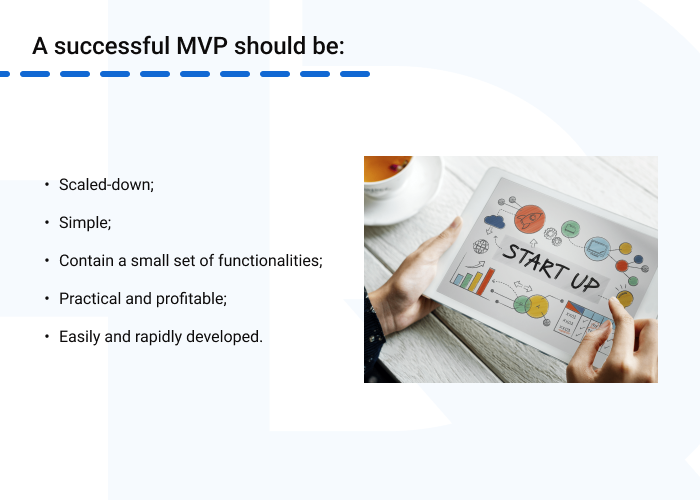Mistakes to Avoid When Building an MVP
Developing a Minimum Viable Product (MVP) is a critical step in the software product development process. But several errors often made in creating an MVP can result in expensive delays and wasted resources. In this article, we’ll talk about how to develop an MVP that meets the client’s needs, the most common pitfalls to avoid, and how to build successful products.
What is an MVP
The best method for launching your product and deriving income quickly is to create an MVP. An MVP is a fully functional product that has enough features to appeal to early adopters and prove an idea. It has all the main qualities of a final solution, such as usefulness, functionality, and original UI/UX design. Starting with an MVP helps development teams swiftly obtain user feedback, so they can iterate and enhance the product. A successful MVP enables your business to more quickly determine and confirm the product-market fit and validate whether the product is relevant enough to be launched.
According to Startup Statistics 2023, only 2 out of 5 startups will be profitable, while the remaining startups will either break even (1 in 3) or continue to lose money (1 in 3). To ensure your MVP is profitable, it’s important to prevent common missteps. First and foremost, you need to be aware of the specifics to focus on and avoid certain mistakes.

Mistakes to Avoid When Building an MVP
According to the research, 9 out of 10 startups fail, and only 1% become unicorn firms. Startup failure rates appear to be similar across all industry sectors. A business that wants to validate its concept and make sure the product is applicable to the market should develop an MVP, keeping in mind that building one can turn into an expensive venture for a small company if not done the right way.
There are various reasons for failure. A crucial ingredient to building a successful MVP is a strong product management and software engineering team. A future-proof MVP is one built with scalability in mind, with an understanding of far-reaching effects and advanced technologies. If your project scope and goals are not clearly defined, you risk losing focus and direction. It’s also important to incorporate user feedback into the design process to guarantee that the MVP fulfills the needs of potential users.

Failing to Do Sufficient Market Research
The first error companies may make is to rush into creating an MVP without conducting proper market research. CBI Insights states that failing to realistically predict market demand is the leading cause of startup failure. Startups may take 2-3 times longer to verify their market than bigger companies. Poor knowledge of the processes required to create the full-fledged product and lack of evidence to support the idea’s marketability may lead to failure. The right way to understand the existing product landscape and evaluate the needs of your potential consumers is through market testing.
You need to learn from your target clients whether the issue you are proposing to solve is actually a problem. Gather information, then refine your MVP project to be practical and realistic, based on the facts you’ve collected. If you’re not satisfied with the outcome of your research, rework the study, enhance it, and incorporate the improvements into your MVP.
A Weak Product Team
Low-level founding teams account for 23% of significant failure cases. Accounting, recruitment, and other non-income-producing activities can take up about 40% of a startup owner’s time, which slows down the project. A startup’s chances of failing increase when it has reached the point of having 11 to 50 employees.
The prosperity of a small business depends on having a diversified team with a range of skills and expertise. Lack of a roadmap and unclear requirement management lead to inconsistent team collaboration. Weak requirements management greatly affects the software development process, causing task breakdowns, deadline violations, and poor product quality. The MVP product development team must include at least a project manager, business analyst, designer, developer, and QA engineer to produce a successful product. The typical recruiting process for a startup lasts six months. Before hiring a startup software development company, you should take into consideration the following aspects:
- diversity of the company’s portfolio;
- workflows, terms of employment, and models of collaboration;
- customer stories and reviews;
- website and social media accounts, and the published content;
- soft skills such as having a common strategic vision and open dialog.
Lack of Competitive Analysis
The possibility of a company failing due to competition increases after 3 to 5 years of operation. Numerous competitors may show up after an idea gains traction or receives market approval. This situation accounts for 19% of failures. If competitors’ analytics are not integrated into the MVP, all your work could be for nothing. Gather as much useful information as you can during the MVP rollout phase to refine and direct product development.
Design your MVP for a particular target audience. This is the most effective way to get relevant, high-quality feedback that can be helpful to set your product roadmap. After a successful launch, you can then progressively grow your audience.
Skipping Prototyping and Ignoring the Testing Stage
Prototyping is important, regardless of whether it is hardware or software. An unfriendly design is responsible for up to 17% of failures. Sometimes startups fail to test their prototypes with actual consumers, a classic error. Often, they are afraid to give out too much information about the product at the MVP stage. So, they try to gather feedback without drawing in actual consumers, and this mistake could be costly.
Troubleshooting, iteration, and modification are critical steps in the creative process that help produce more lasting designs. Prototypes are excellent learning tools that assist in a variety of problem-solving activities. They are also a powerful instrument for attracting investment. In the prototyping stage, problems are revealed, leading to improvements in the MVP development process. This frequently means better results.
Not Gathering User Feedback
The primary goal of developing an MVP is to get user input. Ignoring this input indicates that you no longer care about the primary driver behind creating your MVP. As 14% of startups fail because they don’t properly respond to their customers’ demands, it’s crucial to pay attention to them. Typically, this happens when your focus is diverted from the problem at hand. You can wind up producing something nobody wants.
To create a superior product, gather data. Concentrate on a single market subsegment. Remember that no software solution can satisfy every need. You may need information about particular elements of the software, the general look or feel, or foreseeable future expectations. Never forget that the MVP is designed to demonstrate whether the final product can address the issue experienced by your target audience.
An Unclear Strategy
Verify that the product will support the strategic objectives of your team or business. A plan for the strategic success of your MVP will identify forecasted profit in the upcoming months, limited and unlimited resources available, ways of attracting new users, and clear domain expertise. Domain expertise is the responsible factor in a breakdown rate of 9%.
Without a secure strategy, your development team will not meet your objectives, which means wasted time and money and decreased motivation—and the industry won’t adopt your MVP. To avoid that, identify and concentrate on your benefit statement, choose key functionalities, try to create a small, high-quality solution, and try it out to rapidly deal with any problems that arise. Remember that the purpose of developing an MVP is to test the viability of your product with a few of the many possible features.
Want to develop a successful MVP? We’re ready to help!HQSoftware is ready to develop a successful MVP to raise your business to a new level.
Anna Halias
Business Development Manager
Lack of Focus on Core Features
Many MVPs fall short of their intended goals by implementing extended functionality. The MVP will become ineffective if you try to supply too many elements, as they may not be fully fleshed out for some time. Selecting core functions for testing is one of the major issues in creating an MVP. It is reasonable to cover a few of your preferred tertiary features, but keeping a constrained scope will allow you to reduce spending and accelerate time to market. It’s crucial to find a fair balance between good quality and speedy development.
Don’t allow feature creep. The MVP’s primary aim is to test the product’s fundamental characteristics and demonstrate to users how your product works. If the MVP is a success, later versions might add more features.
Low Scalability
To prepare for an increase after the MVP proves successful, it must be developed with scalability and versatility in mind. Most startups have a strategy in the event of failure, but many fail to plan for success. Building an MVP should be a creative process for each member of the product team, no matter whether they are working on key functionality, providing market analysis, or going through prototyping.
Preparation for future flexibility and scalability is another principal factor in the future success of your project. When developing your MVP, you need to understand how the smallest mechanical details can result in large-scale effects.
MVP Development with HQSoftware
Building an MVP can be a wonderful approach to testing a new idea without expending a lot of time and resources. However, it’s necessary to develop it properly. By cooperating with HQSoftware, you can create a successful MVP that will help you experience the development and success you want.
-
Expert Level
At HQSoftware, we have a lot of experience cooperating with startups, from the idea stage to the POC. We know exactly how to create a perfect MVP. We easily strike a balance between startup requirements and a level of quality needed for effective product performance. The outcomes for our customers who were successful in growing their IPO and going public attest to this.
-
Rapid Launching
We follow a proven implementation strategy in our development processes. This lessens the possibility of delays and offers other advantages, such as a correctly prioritized backlog. As a result, you can expect to get an outstanding solution within 3 to 6 months. Security and IP rights are guaranteed.
-
Concept Confirmation
To avoid wasting resources on a product that has no future, our team provides full-scale solutions, allowing you to test the feasibility of your business idea and observe how it works in operation. Our best-in-market professionals provide top-notch development methods to minimize startup risks and decrease MVP development costs.
-
Optimal Resource Management
Our professionals develop a high-caliber MVP and contribute to effective resource management. We chose the best technology stack and a development team based on your company’s objectives to quickly, and at a lower price, produce an MVP. We can help you focus on the essential elements required for a successful MVP and offer you technical guidance.
Contact us to get more information about how we can help you develop a successful MVP.
Conclusion
When it comes to building an MVP, you should be aware of several common mistakes and avoid them. Lack of preparation and market research could result in a hurried, poorly thought-out product. If the MVP is not fully tested and the user experience is not prioritized, the end product might not satisfy the needs of the target market. A project may also fail or cost more than anticipated if a suitable budget or client input are not considered.
To achieve a successful MVP launch, it’s crucial to:
- have a well-thought-out plan;
- carry out market research analysis;
- prioritize the user experience;
- make a prototype and test it;
- pay attention to the details;
- ask for customer feedback.
By following these tips and avoiding these common mistakes, you will be well on your way to creating a successful project.

Head of Production
To ensure the outstanding quality of HQSoftware’s solutions and services, I took the position of Head of Production and manager of the Quality Assurance department. Turn to me with any questions regarding our tech expertise.
Related Posts
View AllFrequently Asked Questions
Why do MVPs fail?
What to do before launching an MVP?
What makes a successful MVP?
How long should an MVP last?
We are open to seeing your business needs and determining the best solution. Complete this form, and receive a free personalized proposal from your dedicated manager.

Sergei Vardomatski
Founder






